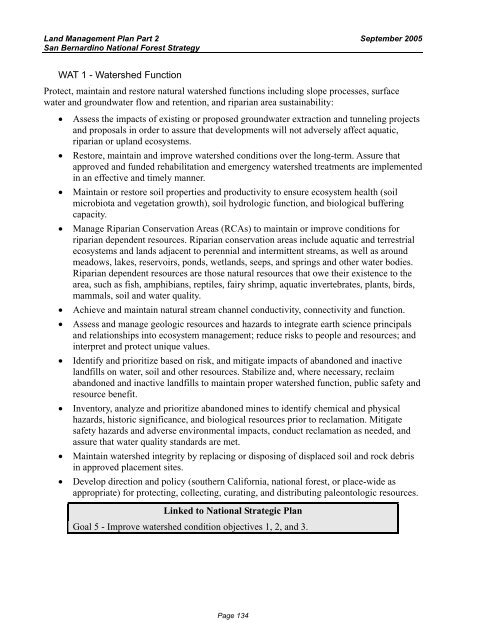San Bernardino National Forest Land Management Plan - Part 2
San Bernardino National Forest Land Management Plan - Part 2
San Bernardino National Forest Land Management Plan - Part 2
You also want an ePaper? Increase the reach of your titles
YUMPU automatically turns print PDFs into web optimized ePapers that Google loves.
<strong>Land</strong> <strong>Management</strong> <strong>Plan</strong> <strong>Part</strong> 2<br />
<strong>San</strong> <strong>Bernardino</strong> <strong>National</strong> <strong>Forest</strong> Strategy<br />
WAT 1 - Watershed Function<br />
September 2005<br />
Protect, maintain and restore natural watershed functions including slope processes, surface<br />
water and groundwater flow and retention, and riparian area sustainability:<br />
• Assess the impacts of existing or proposed groundwater extraction and tunneling projects<br />
and proposals in order to assure that developments will not adversely affect aquatic,<br />
riparian or upland ecosystems.<br />
• Restore, maintain and improve watershed conditions over the long-term. Assure that<br />
approved and funded rehabilitation and emergency watershed treatments are implemented<br />
in an effective and timely manner.<br />
• Maintain or restore soil properties and productivity to ensure ecosystem health (soil<br />
microbiota and vegetation growth), soil hydrologic function, and biological buffering<br />
capacity.<br />
• Manage Riparian Conservation Areas (RCAs) to maintain or improve conditions for<br />
riparian dependent resources. Riparian conservation areas include aquatic and terrestrial<br />
ecosystems and lands adjacent to perennial and intermittent streams, as well as around<br />
meadows, lakes, reservoirs, ponds, wetlands, seeps, and springs and other water bodies.<br />
Riparian dependent resources are those natural resources that owe their existence to the<br />
area, such as fish, amphibians, reptiles, fairy shrimp, aquatic invertebrates, plants, birds,<br />
mammals, soil and water quality.<br />
• Achieve and maintain natural stream channel conductivity, connectivity and function.<br />
• Assess and manage geologic resources and hazards to integrate earth science principals<br />
and relationships into ecosystem management; reduce risks to people and resources; and<br />
interpret and protect unique values.<br />
• Identify and prioritize based on risk, and mitigate impacts of abandoned and inactive<br />
landfills on water, soil and other resources. Stabilize and, where necessary, reclaim<br />
abandoned and inactive landfills to maintain proper watershed function, public safety and<br />
resource benefit.<br />
• Inventory, analyze and prioritize abandoned mines to identify chemical and physical<br />
hazards, historic significance, and biological resources prior to reclamation. Mitigate<br />
safety hazards and adverse environmental impacts, conduct reclamation as needed, and<br />
assure that water quality standards are met.<br />
• Maintain watershed integrity by replacing or disposing of displaced soil and rock debris<br />
in approved placement sites.<br />
• Develop direction and policy (southern California, national forest, or place-wide as<br />
appropriate) for protecting, collecting, curating, and distributing paleontologic resources.<br />
Linked to <strong>National</strong> Strategic <strong>Plan</strong><br />
Goal 5 - Improve watershed condition objectives 1, 2, and 3.<br />
Page 134
















